Thursday March 3, 2016
For: Satisfyingly muscular drivetrain, stunning off-road ability, peerless build quality, useful safety technology.
Against: Uncomfortable rearmost seats, messy dashboard, expensive.
Score: 3.7/5
By Richard Bosselman
LOOKING for a single word that says everything about the Land Cruiser 200-Series in a nutshell? ‘Enduring’ is as good as any, I’d suggest.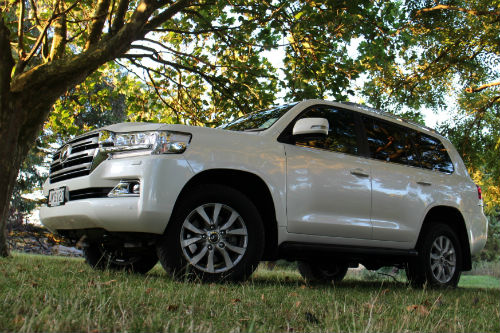
For several reasons. First, it reminds that the largest sports utility that Japan’s biggest and most powerful auto maker produces is also one of its longest-lived; cars with rare exception (take a bow, assuming your weary bones still allow you to do so, Mitsubishi Lancer) generally leave production after seven to nine years. But big, tough bush-basher machines, perhaps because of their huge development costs and more limited sales appeal, are expected to stay around for much longer.
So that’s the sales and lifespan side. ‘Enduring’ also covers actual life expectancy that, thanks to an incredible durability, is just amazing for the 200-Series. There’s a good reason why this model is called the Sahara in some markets. It’s tougher than the presidential nuclear bunker. You could potentially run one of these on Mars.
So that’s ‘enduring’. Is it still endearing? SUV tastes have changed massively since this machine came out and the thing about age is that .. um … it ages. The process cannot be reversed, but it can be disguised.
After nine years’ production – a term that makes it the second longest-lived of its type here, behind the Mitsubishi Pajero – the 200-Series has undergone a big refresh; actually it’s second though this one is more comprehensive than the first, given it delivers new safety technology, an engine upgrade and revised styling inside and out.
Toyota still isn’t saying when this model is due for retirement, so the presumption is that this rework is set to keep it going until maybe 2020.
Style, specification
SEEN that hexagonal grille, set-back headlamps – LEDS, of course - and heavily sculpted bonnet before? Of course you have. Just in slightly smaller scale. This bluff frontal revision ensures the biggest boy in the family now has the same look as the smaller Fortuner and Highlander.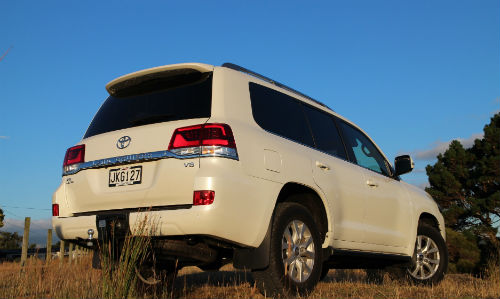
Common facial recognition is all good, but as a colleague quipped to me, the new visage has the effect of not only making this model even more imposing – as if it needed to be that – but also lends impression that it has become even bigger. Dunno if that’s a good thing for a vehicle that, in being 4990mm long, 1980mm wide and 1945mm high already fills up quite a lot of roadscape.
The other enhancements for this VX Limited grade as all window dressing, though they’re actually affecting areas above (chrome roof rails) and below (fresh wheel styling, new tail-lights) the glasshouse.
Inside, this eight-seater has new displays, power tilt adjustment for the steering wheel and the satellite navigation now has the Suna traffic information system that is useful in cities – not applicable in the countryside.
The bigger buy-in is implementation of more driver-assistance and safety features: the VX has the Toyota Safety Sense (TSS) package that now includes a front radar and front camera with forward collision warning and autonomous emergency braking capabilities along with active cruise control and automatic high beams.
Blind spot monitoring with rear cross-traffic alert is also now provided and you’ll be grateful for it; with vehicles of this size and substance, the better the all-round view, the safer we all are.
New padding on touch points, additional storage and a larger 9.0-inch display screen are useful enhancements. Even though controls have been regrouped, there are still too many buttons in too many weird places – worse still, some of the more important ones seem to be in the most awkward locations.
Power, performance
Power out of the sole choice 4.5-litre twin-turbo diesel V8 has crept up slightly, to 200kW, but it's a negligible increase and one not noticeable on the road. More relevant is that there’s a mountain of torque - unchanged at 650Nm of torque, but the most useful figure for this vehicle nonetheless.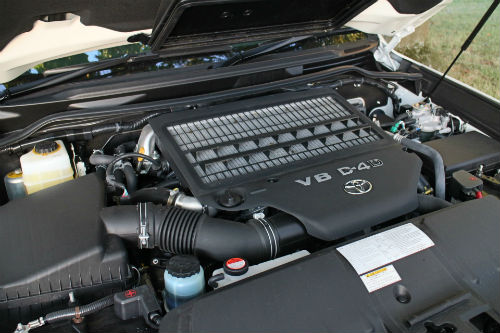
That peak torque is on tap from just 1600rpm and makes relatively light work of the Cruiser’s 2740kg heft.
Though the vehicle never had more than two occupants and a work bag on board for the majority of the time, we know from past experience that loading it up barely interrupts the muscular performance.
Start-off performance is quite impressive for such a big lugger but don’t go stupid about it – there’s a reason why they call it a ‘cruiser’. The engine operates nicely with the auto. A six-speed is a little old hat by today’s standards (actually, this engine is getting long in the tooth, too), but it slurs between ratios decisively and smoothly. And because the engine is generally barely operating at around 1700rpm when you’re schmoozing along at highway pace, it’s respectably muted and refined.
Obviously it is actually working relatively hard, however, because from this experience the claimed overall economy of 9.5 litres per 100km is not easily achieved. The test drive included some urban running, but the majority of kays were clocked over six hours of open road work. At the end of which, the trip computer revealed an average of … 12.8L/100km.
Driving
IN some markets they call this a ‘king of the road.’ Adding ‘off’ as a prefix to the last word works better, I feel.
Basically, I’d sum it up this way. I live on the outskirts of town. Turn right, and you’re into a townscape within five minutes; go left and it is countryside for hours. This thing always felt much more comfortable in the wide open spaces than in the confines of the suburbs.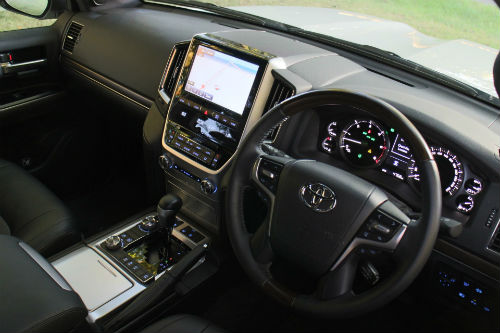
Yet wherever it roams, the sheer mass and huge shadow places a different kind of demand. There’s no escaping the size and weight.
You cannot drive a ‘Cruiser like a car on the highway; arrive briskly at a bend and though it has surprisingly good grip and balance, and is assisted Toyota Kinetic Dynamic Suspension System (KDSS) - which introduces hydraulic anti-roll technology for improved on-road stability (as well as more axle articulation for off-road driving) - the laws of physics cannot be denied. Those baggy off-road tyres will squeal in protest and the body will lean, too. Occasionally, mid-corner bumps might also send a subdued shimmy back through the chassis and steering, but otherwise it feels solid enough to make you think that, if a corner is ultimately beyond its capability, you could simply carve a new track anyway.
Ironically, the provision of lane-keep technology only accentuates the vehicle’s width. It seems you only have to so much think about slicing a new millimetres off that cornering line and it’s beeping away, warning of an imminent centre or side line intrusion. In the end, I just deactivated this and used my own judgement.
Of course, on-road operation is only half the story. In fact, sticking to the seal and tooling around really is an under-utilisation of a massive resource. It demands to be driven in its natural habitat to truly appreciate its breadth of ability and effort that's gone into engineering and even then logically the only buyers of this vehicle now should be upcountry types whose only property access comprises 20kms of gravel track, a couple of river crossing and perhaps a mountain to ascend. That the reality is likely to be entirely different is a crying shame, really.
The Multi-Terrain Select, where the driver selects an off-road mode (there are five) to suit the landscape ahead and also alters traction control and anti-locking brake settings accordingly, is a fail safe system but even if you’re not too fussy with it, this rig is a seriously impressive device in everything from rocks and sand to mud and water. As with most serious off-roaders it has a low-range four-wheel drive system for the really tough stuff. It's also rated to tow 3500kg, which equals other big four-wheel drives.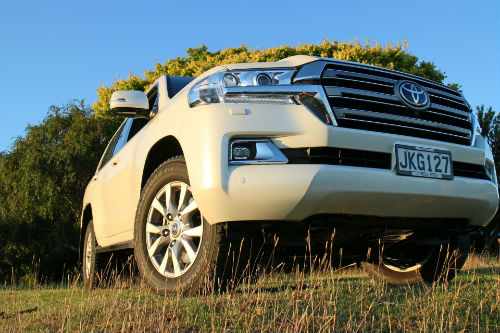
Of course, if that’s inconsequential to you – and I fear that it will be to far too many – then there are plenty of other things to keep you occupied. The standard specification on the top-of-the-line VX Limited Cruiser here has increased to ‘bumper’ level. There’s a four zone climate control air conditioning, a chilled centre console compartment, bluetooth telephone capability, audio controls, climate controls, cameras, second row rear seat heaters, trip computer with twin trip meters, steering wheel angle display, digital speed display, turn-by-turn navigation display and whereas previously there was a single video screen in the back, a big one that powered down from the roof lining, now there is a pair, each attached to a front seat back and with their own headphones. No such stuff for the occupants of the rearmost chairs, though. Their best entertainment is the outside world.
The third row is obviously also for best for children, but only of a certain age band. Too old and they won’t fit well, but you can’t have ‘em too young either, as this position does not have any child seat anchor points. That third row of seats, too, folds against the side of the car rather than into the floor, so it eats into luggage space a bit.
But the split tailgate is a handy setup, with the lower section folding for a handy temporary picnic table or place to prop the kids as you de-sand them after the beach.
Of course, it also raises the price. In this instance, to $143,990. Or you can just keep it sensible and buy into the next-step-down VX … and save $22,000.
Verdict
Used as it is designed to be, the big daddy Land Cruiser is simply brilliant. You won’t find a more dependable or more durable vehicle out of Japan. It’s also a very useful vehicle for hauling loads of significant substance. If you need to shift a castle, this is your best pick, one you can buy and use with confidence.
But if intention is to use it as a bigfoot bus, then ownership justification is more challenging. While the Land Cruiser 200 Limited makes a far fist of carrying seven people in reasonable comfort, it is not as well-suited to this role as many newer, more car-like alternates. Often during our road drive, it just left impression of being a super-sized, hard-drinking lane hog. Also, it’s not a cheap buy-in: Safety aides aside, some of the fills are outright fripperies. I’d suggest a smart buyer’s bucks should stop at the VX.
Even then, it’s understandable why the 200 has become a niche choice. Come the day when we’re on Armageddon alert, this rig would always be an optimal choice. In the meantime, or at least until Donald Trump becomes the next US president, I’d probably look for something that still did country stuff well but was also a little more city-friendly.


